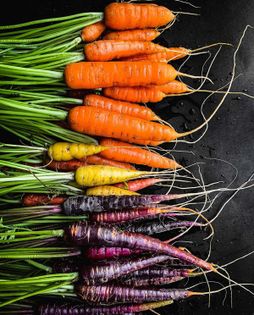What we know as carrots today are domesticated forms of wild carrot (a.k.a. Queen Anne’s Lace). The domesticated carrot has its roots in Central Asia, i.e., modern-day Iran and Afghanistan. Though most people know of orange carrots, there are in fact several varieties of white, yellow, red, and purple carrots to suit all tastes and preferences. Growing carrots in a home garden setting can be tricky if timing and conditions are not ideal. One of the most common complaints about homegrown carrots is that they taste soapy or piney. What gives carrots their flavor is a balance of sugars and terpenoids, volatile compounds which can often be described as smelling and tasting of pine, wood, or even turpentine. Young carrots develop terpenoids first, and if harvested too early, a carrot can taste bitter and soapy. As carrots mature, natural sugars develop through photosynthesis. These sugars are stored in the root. Carrots are cool-weather vegetables and perform best in regions with a prolonged cool growing season.


